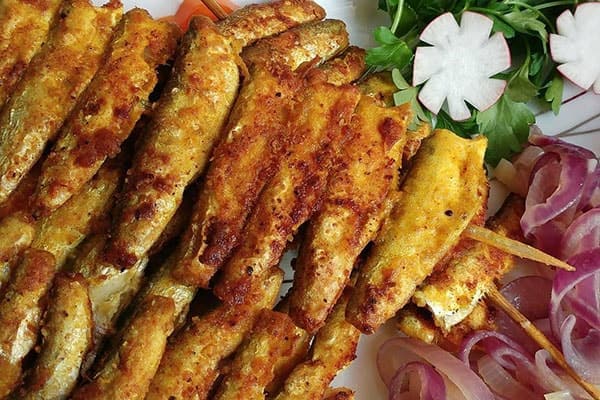User
Login/Register

Login/Register





Ingredients (2 servings)
Preparation Steps (30 minutes)
Boil the canned tuna in water for 20 minutes to eliminate any possible toxins.
Drain and discard the water and oil from the can.
Lightly shred the tuna.
Mix the shredded tuna with chopped hard-boiled eggs, bell pepper, and olives.
Season with salt, pepper, paprika, and mayonnaise, then mix well.
(Be careful with the salt, since tuna and olives are already salty.)
For best flavor, refrigerate the mixture for at least 1 hour to let the tastes blend together.

۱. Pacific White Shrimp (Litopenaeus vannamei)
Intensive/Super-Intensive: High-density farming in controlled ponds with artificial feeds, aeration, and daily water exchange (e.g., super-intensive indoor systems in China, ISIC).
Semi-Intensive: Medium-density ponds with supplemental feeding and partial water exchange (common in Ecuador, Mexico, and Brazil).
Integrated Multi-Trophic Aquaculture (IMTA): Combining shrimp with algae or fish to reduce waste and improve sustainability (e.g., PIMTA model in China).
Key Regions: Latin America (Ecuador, Brazil), Asia (India, Vietnam, China), United States (Texas).
۲. Giant Tiger Prawn (Penaeus monodon)
Extensive: Low-density ponds relying on natural tidal exchange and minimal feeding (traditional systems in Bangladesh, Indonesia).
Semi-Intensive: Fertilized ponds with supplemental feeding and limited water management (common in Thailand and Vietnam).
Intensive: High-density ponds with artificial feed, aeration, and strict disease control (e.g., Thailand, Philippines).
Key Regions: Southeast Asia (Thailand, Indonesia), South Asia (India, Bangladesh).
۳. Indian White Shrimp (Penaeus indicus)
Extensive/Semi-Intensive: Brackish ponds with natural seed stocking and supplemental feeding (common in India and Iran).
Polyculture: Often integrated with milkfish or crabs to optimize pond productivity (e.g., Philippines).
Key Regions: Middle East (Iran, Saudi Arabia), South Asia (India, Sri Lanka).
۴. Kuruma Shrimp (Marsupenaeus japonicus)
Super-Intensive: Indoor tanks or covered ponds with advanced water recirculation (Japan, South Korea).
Greenwater Hatcheries: Algal bloom tanks for larval feeding (common in Japan).
Key Regions: East Asia (Japan, China), Mediterranean (Spain, Italy).
۵. Giant Freshwater Prawn (Macrobrachium rosenbergii)
Pond Culture: Freshwater ponds with controlled salinity and organic feeds (e.g., Bangladesh, Thailand).
Integrated Farming: Combined with rice or vegetable farms in rotational systems (e.g., Vietnam).
Key Regions: Asia (Bangladesh, India), Latin America (Brazil).
۶. Banana Shrimp (Fenneropenaeus merguiensis)
Extensive: Mangrove ponds with tidal water exchange (Indonesia, Australia).
Semi-Intensive: Fertilized ponds with supplemental feeding (common in Thailand).
Key Regions: Southeast Asia (Thailand, Malaysia), Northern Australia.
۷. Blue Shrimp (Litopenaeus stylirostris)
Semi-Intensive: Medium-density ponds with partial water exchange (Mexico, Panama).
Biofloc Technology: Recirculating systems with microbial bioflocs to maintain water quality.
Key Regions: Latin America (Mexico, Ecuador).
Sustainability: Integrated systems (e.g., PIMTA, IMTA) and mangrove preservation are priorities to minimize environmental impact.
Disease Management: Intensive systems often face challenges such as White Spot Syndrome Virus (WSSV), requiring strict biosecurity.
Feeding Practices: Semi-intensive and intensive systems rely on commercial feeds, while extensive systems depend on natural productivity.
For more details on region-specific practices or certification standards (e.g., ASC), please refer to specialized resources.

Caspian kilka is a small fish caught from the Caspian Sea. Despite its small size, it is edible, delicious, and packed with nutrients such as calcium, phosphorus, and vitamins A and B. Kilka can be enjoyed fried, grilled, or served with rice.
Kilka fish – ۵۰۰ g
Egg – ۱
Onion – ۱
Lemon juice – ۵ tablespoons
Bread crumbs – as needed
Garlic powder – ۱ teaspoon
Oil – as needed
Salt and pepper – to taste
Prepare the fish: Clean the fish thoroughly. Remove the head, tail, and fins. Gut the fish and take out the backbone, then wash well.
Marinate: In a medium bowl, add the sliced onion, salt, black pepper, garlic powder, and lemon juice. Add the fish to the bowl, cover with plastic wrap, and refrigerate for 2–۳ hours. This helps flavor the fish and remove any unpleasant odor.
Skewer the fish: After marinating, take the fish out of the fridge and thread them onto wooden skewers, leaving a little space between each one.
Coating: In one large dish, spread out the bread crumbs and any extra spices you like. In another dish, beat the egg. Dip each skewer first into the beaten egg, then roll it in bread crumbs until fully coated.
Frying: Heat some oil in a frying pan over medium heat. Place the skewers in the pan and fry until golden. Once one side is crisp, flip to cook the other side.
Serve: Enjoy fried kilka skewers with herbed rice or plain rice, along with fresh herbs and salad.